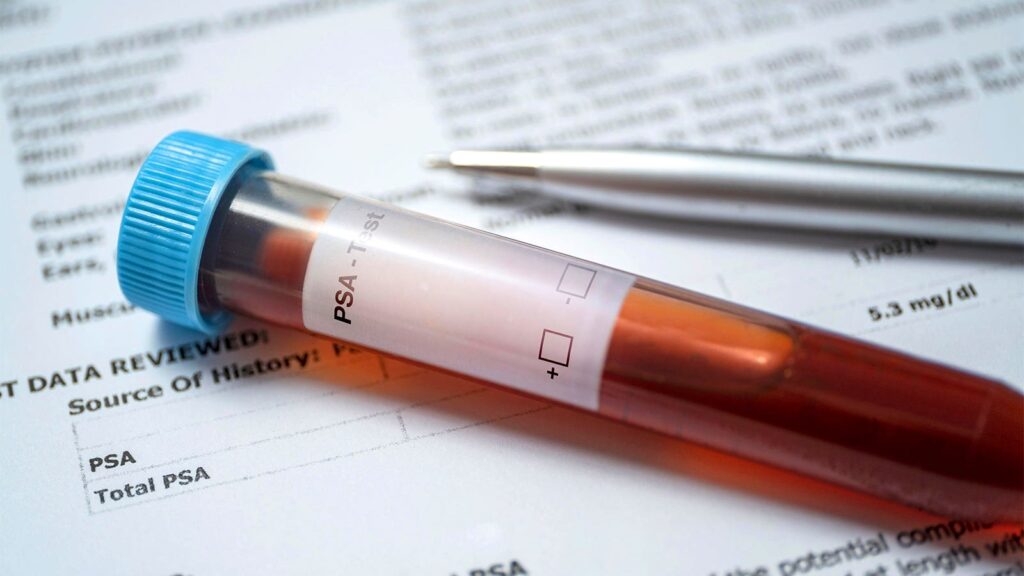A single round of prostate cancer screening that included a prostate-specific antigen (PSA) test, a kallikrein panel, and an MRI detected one additional high-grade cancer per 196 men and one low-grade cancer per 909 men, according to preliminary results from the Finnish ProScreen randomized trial.
The risk difference for the group randomized to the screening invitation compared with the control group who were not invited to undergo screening was 0.11% (95% CI 0.03-0.20) for low-grade cancer and 0.51% (95% CI 0.33-0.70) for high-grade cancer, reported Anssi Auvinen, MD, PhD, of Tampere University in Finland, and colleagues in JAMA.
Of 7,744 men who participated in screening, 32 low-grade prostate cancers and 128 high-grade prostate cancers were detected. Among the 7,457 invited men who refused participation, seven low-grade cancers and 44 high-grade cancers were detected.
For the entire invited screening group, 39 low-grade prostate cancers and 172 high-grade prostate cancers were detected. During a median follow-up of 3.2 years for the group not invited to undergo screening, 65 low-grade cancers and 282 high-grade cancers were detected.
The overall cancer detection rate among men who were screened was 2.07%, with a yield of about 1.7% for high-grade cancers and 0.4% for low-grade cancer.
Auvinen and team pointed out that this high-grade cancer detection rate is comparable to that in the initial screening round of the European Randomized Study of Screening for Prostate Cancer trial (1.8%), which evaluated PSA testing, but the current study protocol reduced the overdetection of low-grade disease (0.4% vs 3.2%, respectively).
This improvement “is the result of more careful selection of patients for biopsy using biomarkers and MRI, reflecting the clear clinical advantages offered by current diagnostic tools relative to a PSA-only approach,” noted Jeffrey J. Tosoian, MD, MPH, of Vanderbilt University Medical Center in Nashville, Tennessee, and colleagues in an editorial accompanying the study.
“Although prior studies have demonstrated the benefits and harms of PSA screening followed by systematic biopsy, the current trial informs a more contemporary, pragmatic approach to screening, with appropriate use of biomarkers and imaging to optimize patient selection for biopsy,” they added.
Auvinen and colleagues cautioned that the results were descriptive “and should be interpreted provisionally, pending results from the trial on the primary outcome of prostate cancer mortality.”
The ProScreen trial was designed to increase the specificity of screening for high-grade prostate cancer, with the idea that a kallikrein panel with four components (total PSA, free PSA, intact PSA, and human kallikrein-2) could reduce the number of men referred to biopsy while retaining sensitivity for high-grade cancer, and MRI in men with elevated PSA could reduce the detection of low-grade prostate cancer.
The trial included 60,745 men ages 50 to 63 (mean age 57 years) who were free of cancer. They were randomized in a 1:3 ratio to be invited or not invited to undergo screening from February 2018 to July 2020. Of 15,201 eligible men invited to undergo screening, 7,744 (51%) participated.
Under this three-phase screening protocol, participants first gave a blood sample to determine PSA. If PSA was 3 ng/mL or higher, participants underwent a 4-kallikrein panel to test for the likelihood of a clinically significant cancer (grade group 2 or higher). Those with a kallikrein panel score of 7.5% or higher underwent a prostate MRI, and those with an abnormality on MRI underwent targeted biopsies of the region of interest, without concurrent systematic biopsies.
Men with a negative MRI result but elevated PSA density (>0.15 ng/mL2) underwent a systematic biopsy in order to avoid missing high-grade cancers.
The authors also performed a supplementary analysis in which they found that treatment for identified prostate cancer was more likely to be active surveillance in the group randomized to screening compared with the control group (32% vs 24%), and less likely to include androgen deprivation therapy (3% vs 7%).
These initial data “reflect the increasingly favorable profile of prostate cancer screening achieved with use of contemporary diagnostic tools,” the editorialists wrote, although the long-term benefits of the three-phase screening approach still need to be determined with follow-up.
Auvinen and colleagues acknowledged that this study has limitations, including the fact that the absolute differences between the two randomized groups were small “and their clinical importance remains unclear.”
They also noted that prior screening reported by many of the participants may have reduced cancer detection compared with a population who had not undergone prior screening for prostate cancer, and that the results were based on a single invitation for screening, suggesting some high-grade prostate cancers were likely missed.
Disclosures
This study was supported by grants from the Academy of Finland, the Finnish Cancer Foundation, the Jane and Aatos Erkko Foundation, the Finland State Research Funding administered by Tampere University Hospital, Helsinki University Hospital, the Sigrid Jusélius Foundation, and the Päivikki and Sakari Sohlberg Foundation. A co-author was supported in part by grants from the National Cancer Institute and the Cancerfonden from the Swedish Cancer Society.
Auvinen had no disclosures. Several co-authors reported relationships with industry.
Tosoian reported receiving grants from the Network and Prostate Cancer Foundation; serving as a scientific advisor to LynxDx; having equity in LynxDx; and having a patent for MPS2 pending with LynxDx. A co-editorialist also reported relationships with industry.
Primary Source
JAMA
Source Reference: Auvinen A, et al “Prostate cancer screening with PSA, kallikrein panel, and MRI: the ProScreen randomized trial” JAMA 2024; DOI: 10.1001/jama.2024.3841.
Secondary Source
JAMA
Source Reference: Tosoian JJ, et al “A pragmatic approach to prostate cancer screening” JAMA 2024; DOI: 10.1001/jama.2024.4089.
Please enable JavaScript to view the comments powered by Disqus.
Source link : https://www.medpagetoday.com/hematologyoncology/prostatecancer/109522
Author :
Publish date : 2024-04-06 08:15:00
Copyright for syndicated content belongs to the linked Source.
